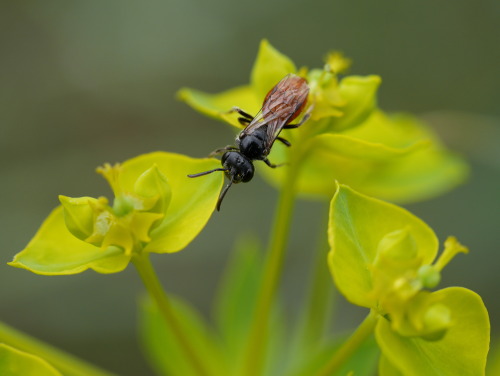#halictidae
Sphecodes(arvensiformis) “Cuckoo Sweat Bee” Halictidae
onEuphorbia esula “Leafy Spurge” Euphorbiaceae
Blue Mountain National Recreation Area, MT
May 16, 2016
Robert Niese
Sphecodesbees are cleptoparasitic, cuckoo-like bees that lay their eggs in the nests of other sweat bees. Despite their outward appearance, these insects are not wasps, but they have converged on a very cuckoo-wasp-like life-history strategy. A female enters the nests of another Halictid, consumes a developing egg and replaces it with her own. Unfortunately, these bees, like the vast majority of Halictids, are very poorly studied and there are few entomologists capable of accurately identifying them beyond the genus level. Oh, and by the way, Leafy Spurge, while it is one of Missoula’s most widespread invasives, is also one of my favorite spring plants. They’re just such odd organisms! More photos and natural history info to come, I’m sure.
Looking back at my other photos of these bees from years ago makes me realize how far my skills as a photographer and natural historian have progressed.
Post link
Lasioglossum(Hemihalictus) sp. “Weak-veined Sweat Bee” Halictidae
onSolidago missouriensis. “Prairie Goldenrod” Asteraceae
Apgar Lookout Trail, Glacier National Park, MT
October 9, 2015
Robert Niese
Lasioglossum is the world’s largest genus of bees and contains more than 1700 species worldwide. Like many other speciose invertebrate genera, we know relatively little about these organisms and only a handful of entomologists worldwide are capable of identifying them to species. In the last five years, researchers throughout North America have revised the taxonomy of this group using phylogenetic data, new morphological characters, and over 10,000 museum specimens. According to their keys, this particular individual is possibly a male L. (Hemihalictus)inconditum.
Post link

Bug of the Day
A tiny sweat bee on clover, from the archives (June 2005). Yes, that’s right, I have been photographing bugs longer than some of you have been alive…


